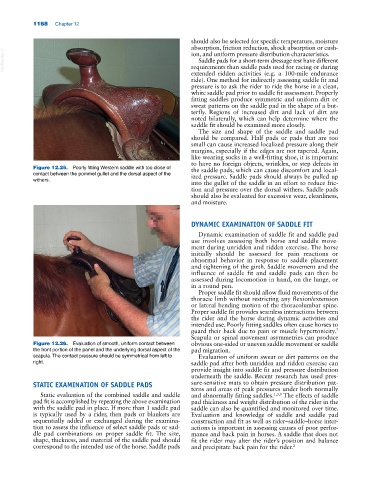Page 1202 - Adams and Stashak's Lameness in Horses, 7th Edition
P. 1202
1168 Chapter 12
should also be selected for specific temperature, moisture
absorption, friction reduction, shock absorption or cush
VetBooks.ir requirements than saddle pads used for racing or during
ion, and uniform pressure distribution characteristics.
Saddle pads for a short‐term dressage test have different
extended ridden activities (e.g. a 100‐mile endurance
ride). One method for indirectly assessing saddle fit and
pressure is to ask the rider to ride the horse in a clean,
white saddle pad prior to saddle fit assessment. Properly
fitting saddles produce symmetric and uniform dirt or
sweat patterns on the saddle pad in the shape of a but
terfly. Regions of increased dirt and lack of dirt are
noted bilaterally, which can help determine where the
saddle fit should be examined more closely.
The size and shape of the saddle and saddle pad
should be compared. Half pads or pads that are too
small can cause increased localized pressure along their
margins, especially if the edges are not tapered. Again,
like wearing socks in a well‐fitting shoe, it is important
to have no foreign objects, wrinkles, or step defects in
Figure 12.25. Poorly fitting Western saddle with too close of the saddle pads, which can cause discomfort and local
contact between the pommel gullet and the dorsal aspect of the ized pressure. Saddle pads should always be pulled up
withers.
into the gullet of the saddle in an effort to reduce fric
tion and pressure over the dorsal withers. Saddle pads
should also be evaluated for excessive wear, cleanliness,
and moisture.
DYNAMIC EXAMINATION OF SADDLE FIT
Dynamic examination of saddle fit and saddle pad
use involves assessing both horse and saddle move
ment during unridden and ridden exercise. The horse
initially should be assessed for pain reactions or
abnormal behavior in response to saddle placement
and tightening of the girth. Saddle movement and the
influence of saddle fit and saddle pads can then be
assessed during locomotion in hand, on the lunge, or
in a round pen.
Proper saddle fit should allow fluid movements of the
thoracic limb without restricting any flexion/extension
or lateral bending motion of the thoracolumbar spine.
Proper saddle fit provides seamless interactions between
the rider and the horse during dynamic activities and
intended use. Poorly fitting saddles often cause horses to
guard their back due to pain or muscle hypertonicity.
7
Scapula or spinal movement asymmetries can produce
Figure 12.26. Evaluation of smooth, uniform contact between obvious one‐sided or uneven saddle movement or saddle
the front portion of the panel and the underlying dorsal aspect of the pad migration.
scapula. The contact pressure should be symmetrical from left to Evaluation of uniform sweat or dirt patterns on the
right. saddle pad after both unridden and ridden exercise can
provide insight into saddle fit and pressure distribution
underneath the saddle. Recent research has used pres
STATIC EXAMINATION OF SADDLE PADS sure‐sensitive mats to obtain pressure distribution pat
terns and areas of peak pressures under both normally
Static evaluation of the combined saddle and saddle and abnormally fitting saddles. 1,3,9 The effects of saddle
pad fit is accomplished by repeating the above examination pad thickness and weight distribution of the rider in the
with the saddle pad in place. If more than 1 saddle pad saddle can also be quantified and monitored over time.
is typically used by a rider, then pads or blankets are Evaluation and knowledge of saddle and saddle pad
sequentially added or exchanged during the examina construction and fit as well as rider–saddle–horse inter
tion to assess the influence of select saddle pads or sad actions is important in assessing causes of poor perfor
dle pad combinations on proper saddle fit. The size, mance and back pain in horses. A saddle that does not
shape, thickness, and material of the saddle pad should fit the rider may alter the rider’s position and balance
correspond to the intended use of the horse. Saddle pads and precipitate back pain for the rider. 2

